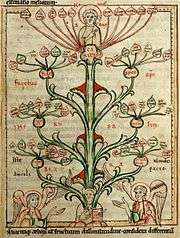Tree of virtues and tree of vices
A tree of virtues (arbor virtutum) is a diagram used in medieval Christian tradition to display the relationships between virtues, usually juxtaposed with a tree of vices (arbor vitiorum) where the vices are treated in a parallel fashion. Together with genealogical trees, these diagrams qualify as among the earliest explicit tree-diagrams in history, emerging in the High Middle Ages.[1]



At first appearing as illustrations in certain theological tracts, the concept becomes more popular in the Late Middle Ages and is also seen in courtly manuscripts such as the psalter of Robert de Lisle (c. 1310-1340).
The nodes of the tree-diagrams are the Cardinal Virtues and the Cardinal Vices, respectively, each with a number of secondary virtues or secondary vices shown as leaves of the respective nodes. While on a tree of virtues, the leaves point upward toward heaven, on a tree of vices the leaves point downward toward hell. At the root of the trees, the virtues of humilitas "humility" and the vice of superbia "pride" is shown as the origin of all other virtues and vices, respectively. By this time, the concept of showing hierarchical concepts of medieval philosophy in diagrams also becomes more widespread. E.g. ms. Arsenal 1037 (14th century) has a tree of virtue on fol. 4v and a tree of vices on fol. 5r as part of a collection of diagrams on a variety of topics.[2] In this example, the trees are also further subdivided into a ternary structure, as follows:
In the Italian Renaissance, Pietro Bembo developed a similar flow-chart-like "moral schema" of sins punished in Dante's Inferno and Purgatory.[3]
See also
- Seven Virtues
- Seven Cardinal Sins
- Works of Mercy
- Tree of Jesse
References
- genealogical stemmata since at least the 11th century, the arbor virtutum since at least the 12th; see Nora Gädeke, Zeugnisse Bildlicher Darstellung Der Nachkommenschaft Heinrichs I, Arbeiten zur Frühmittelalterforschung 22 (1992), p. 2. For the possibility of a genealogiacal stemma of the early 10th century, see Nora Gädeke, Eine Karolingergenealogie des frühen 10. Jahrhunderts?, Francia 15 (1987), 778-792
- Septem hore canonice; Septem actus passionis Christi; Septem dona gratuita; Arbor virtutum; Arbor vicioru; Arbor sapientie; Duodecim prophete; Duodecim articuli fidei; Duodecim apostoli.
- in an early edition of Dante printed by Andrea Torresani (1451-1529), Venice 1515"Archived copy". Archived from the original on 2012-02-05. Retrieved 2012-02-26.CS1 maint: archived copy as title (link)"Archived copy". Archived from the original on 2012-05-05. Retrieved 2012-02-26.CS1 maint: archived copy as title (link)
- Serenus de Cressy, Arbor virtutum or, An exact modell in the which are represented all manner of vertues and graces
- Michael W. Evans, "§3.5 Arbor virtutum" in The Geometry of the Mind (1980)
- A. Watson, "The Speculum Virginum with Special Reference to the Tree of Jesse", Speculum 3.4, October 1928, 445-469.
External links
- Matt Aleksinas (2006). "The Tree of Virtues & The Tree of Vices". Yale University. Retrieved 2008-06-03.
- 15th-century painted mural 'Tree of vices' as the seven-headed dragon of the Apocalypse of St. John (Rev. 12) at Anglican parish church of St Ethelbert’s, Hessett, Suffolk, England